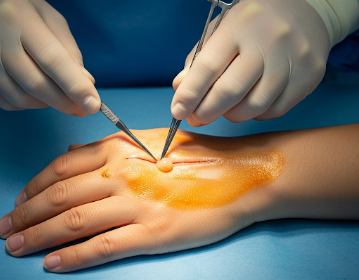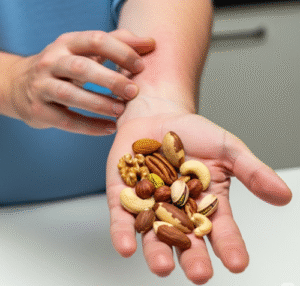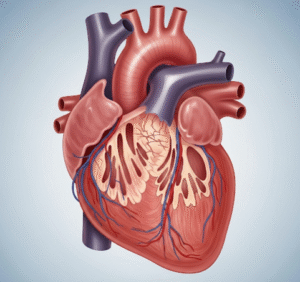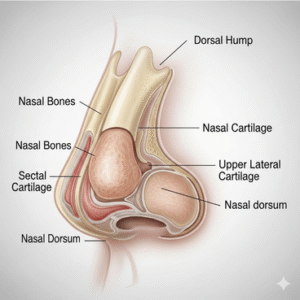Overview
A ganglion cyst is a benign, fluid-filled lump that commonly develops on the wrist, hand, or fingers, and sometimes on the foot or ankle. Although usually painless, ganglion cysts can cause discomfort, limitation of movement, or cosmetic concern.
Excision of a ganglion is a surgical procedure that removes the cyst completely, along with its stalk, to prevent recurrence.
In South Korea, ganglion excision is performed in advanced orthopedic and hand surgery centers. Surgeons use precise microsurgical techniques and minimally invasive approaches, ensuring safe, effective, and cosmetically favorable results.
What is Excision of a Ganglion?
Ganglion excision involves surgically removing the cyst and its connecting stalk to the joint or tendon sheath.
This procedure is usually recommended for:
- Painful or tender cysts interfering with daily activities
- Restricted movement of the wrist, hand, or fingers
- Rapidly growing cysts
- Cosmetic concerns when the cyst is visible and bothersome
- Failed non-surgical management → aspiration or observation
Surgical excision provides definitive treatment, significantly reducing the risk of recurrence compared to aspiration.
What are the benefits?
Excision of a ganglion offers multiple advantages:
- Definitive removal → eliminates the cyst and associated discomfort
- ➤ Restores function and mobility in affected joints
- ➤ Minimally invasive options → small incisions, faster recovery, less scarring
- ➤ Prevents recurrence → removal of the cyst stalk ensures long-term success
- ➤ Cosmetic improvement → smooth contour of the wrist or hand
- ➤ High success rates in Korea with experienced orthopedic and hand surgeons
Procedure Details
1) How should I prepare for Excision of a Ganglion?
Proper preparation ensures safety and optimal outcomes:
- Medical evaluation → review medical history, medications, and imaging (ultrasound or MRI if needed)
- Medication adjustment → blood-thinning drugs may need temporary discontinuation
- Fasting → generally not required if local anesthesia is used; required for general anesthesia
- Informed consent → discuss procedure, risks, benefits, and expected recovery
2) What happens during the procedure Excision of a Ganglion?
The procedure typically takes 30–60 minutes:
- Anesthesia → local anesthesia with sedation or general anesthesia depending on cyst size and patient preference
- Incision → small incision over the cyst site, carefully preserving surrounding structures
- Cyst removal → the ganglion and its stalk connecting to the joint or tendon sheath are excised
- Hemostasis → control bleeding and ensure joint integrity
- Closure → incision is sutured with fine stitches; sterile dressing applied
- Specimen analysis → cyst may be sent for histopathology if needed
In Korea, surgeons emphasize microsurgical precision to prevent damage to nearby nerves, tendons, and blood vessels, ensuring minimal scarring and optimal functional outcomes.
3) What happens after an Excision of a Ganglion?
- Immediate recovery → monitored briefly after anesthesia; patient can often go home the same day
- Pain management → mild analgesics or anti-inflammatory medications
- Activity restriction → avoid heavy lifting or strenuous wrist use for 2–4 weeks
- Wound care → keep the incision clean and dry; follow-up for suture removal
- Physical therapy → may be recommended to restore strength and mobility
- Long-term outcome → cyst rarely recurs when excision is complete
Risks / Benefits
Potential Risks:
- Temporary pain, swelling, or bruising
- Infection at the surgical site (rare)
- Scar formation → usually minimal
- Rare complications → nerve injury, tendon damage, or recurrence of the cyst
Key Benefits:
- Definitive removal of ganglion cyst
- ➤ Restores joint function and reduces discomfort
- ➤ Minimally invasive, cosmetically favorable technique
- ➤ Prevents recurrence when cyst stalk is fully excised
- ➤ High success rates in Korea with expert surgeons
Recovery and Outlook
- Short-term recovery → mild discomfort and limited wrist activity for 1–2 weeks
- Functional improvement → improved range of motion and reduced pain
- Cosmetic results → small, well-healed incision with minimal visible scarring
- Long-term outlook → most patients resume normal activities within weeks, with very low recurrence rates
- In Korea, patients benefit from modern surgical techniques, expert postoperative care, and guided rehabilitation
When To Call the Doctor
Contact your healthcare provider if you experience:
- Severe pain, swelling, or redness at the surgical site
- ➤ Signs of infection such as discharge or fever
- ➤ Numbness or tingling in the fingers or hand
- ➤ Recurrence of the cyst or abnormal swelling
- ➤ Difficulty moving the wrist or fingers beyond expected recovery
Early evaluation ensures safe recovery and optimal functional outcomes.
Best Korea Option / Process
South Korea is a leading destination for ganglion excision surgery:
- Expert orthopedic and hand surgeons → skilled in minimally invasive and microsurgical excision
- Advanced imaging and surgical guidance → ensures precise removal while protecting nerves and tendons
- Comprehensive care packages → preoperative evaluation, surgery, and postoperative rehabilitation
- Minimally invasive outpatient procedures → short hospital stay, rapid recovery
- International patient support → multilingual staff, appointment scheduling, and personalized care
Patients choosing Korea for ganglion excision can expect safe, effective, and cosmetically favorable outcomes, making it a top destination for hand and wrist surgery in Asia.













